This summer, I emptied our small, above-ground swimming pool twice and used the water on my vegetables and fruit trees. What were the results? Thus far, I haven’t observed any response in any plant that indicates the water was harmful.
Swimming pool water has the potential to damage plants and soil because of the chemicals added to it to keep it clean and clear.
Our small pool holds about 2,500 gallons of water, and I had added some chlorine products to the water over the summer to prevent it from going green with algae and breeding mosquitoes. Mostly, I used the Hasa Chlor product, which contains 12.5% sodium hypochlorite (which is sodium, chlorine, and oxygen).
I initially filled the pool in late June, and in late July I drained it. We were heading out to camp at the beach for a week, and rather than running the pump the whole time we were gone and adding a bunch more chemicals to the water, I opted to use the relatively clean water in the yard and then refill it later.
(This also gave my kids and me a learning opportunity. Together, we calculated the cost of the water in the pool by multiplying the gallons by the water rate. That cost, about $25, we compared to the cost of electricity for running the pump and chemicals to kill life in the pool.)
In early August, I filled the pool for the second time. Then on September 9, I drained it again, as summer swimming time was over, and again I irrigated fruit trees and vegetables with the pool water.
It is now two weeks after that final draining and two months after the inital draining, and the plants I irrigated with the water look fine, considering that they also went through a nasty heat wave last week that peaked at 114 degrees.
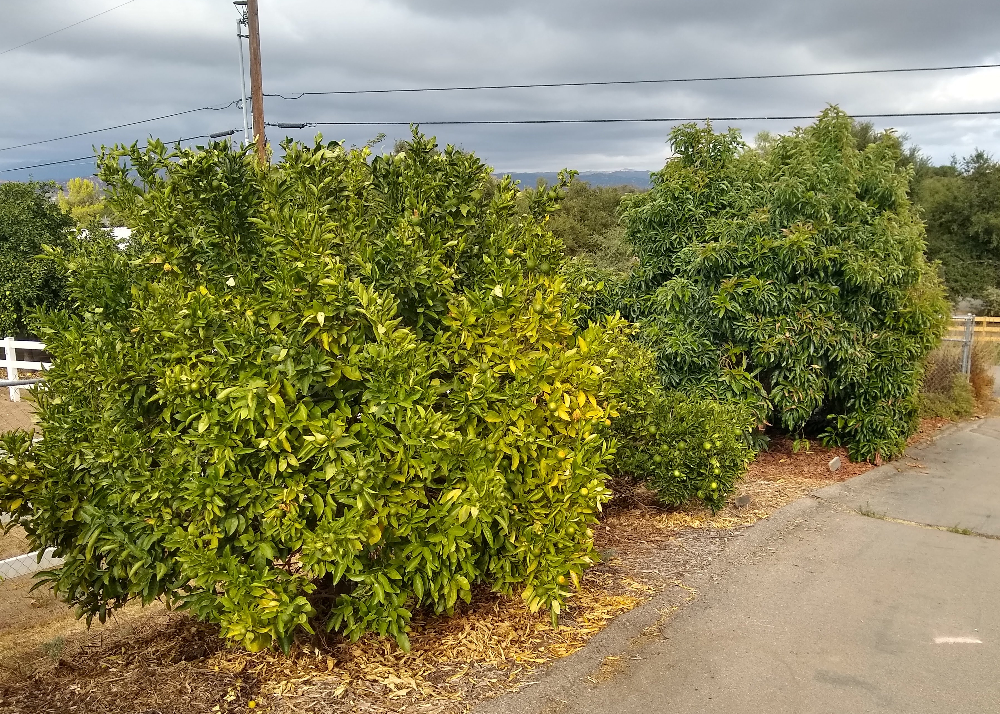
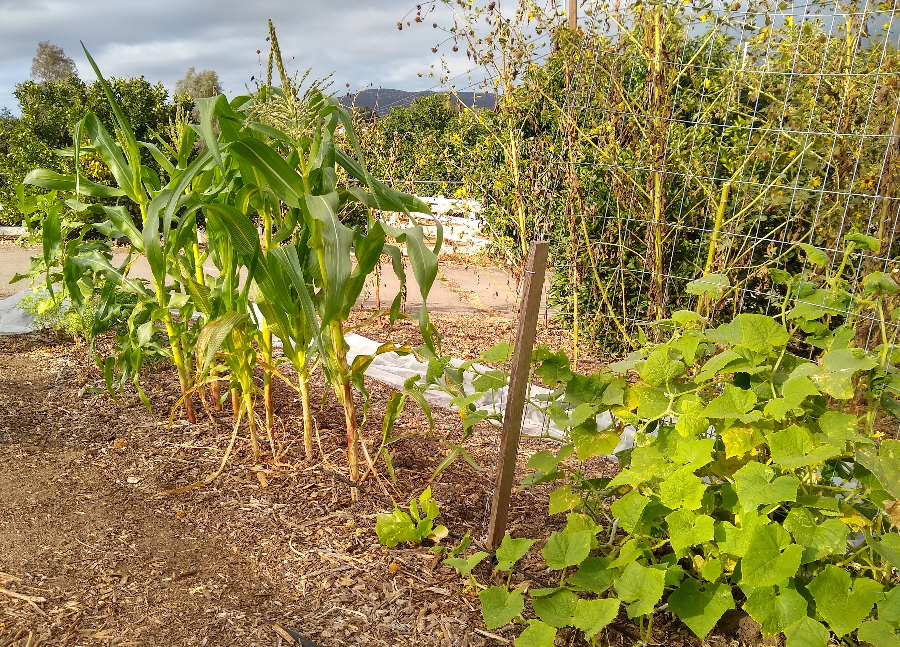
Sodium and chlorine
Plants don’t like a lot of sodium or chlorine in the water they drink. I’ve burned up plants before by using water on them that was too high in those elements (from clothes-washing machine water). Leaf margins yellow then brown, growth stunts . . . the plants generally start to look burned.
So why add this swimming pool water, to which I’ve added sodium and chlorine, to the dirt around my vegetables and fruit trees? In short, I didn’t want to waste it, and I suspected the water didn’t have so much sodium and chlorine that it would damage the plants, as I had added very little of the sodium hypochlorite product.
I never liked the idea of my family swimming in a lot of that bleach solution so I never added as much as recommended. The downside of this was that the pool water didn’t remain clear and clean looking for long; but the upside was that it wasn’t choked with caustic chemicals.
When it came time to drain the pool into the yard I had two additional reasons to think it was safe. The first was that the water seemed to have evaporated most of its chlorine by the time I drained it. I stopped adding any chlorine a week or two before draining, the weather was hot, and the water didn’t take long to turn green and then I noticed some mosquito larvae in it. I figured that If little organisms were finding this water hospitable for life, then maybe my plants would too.
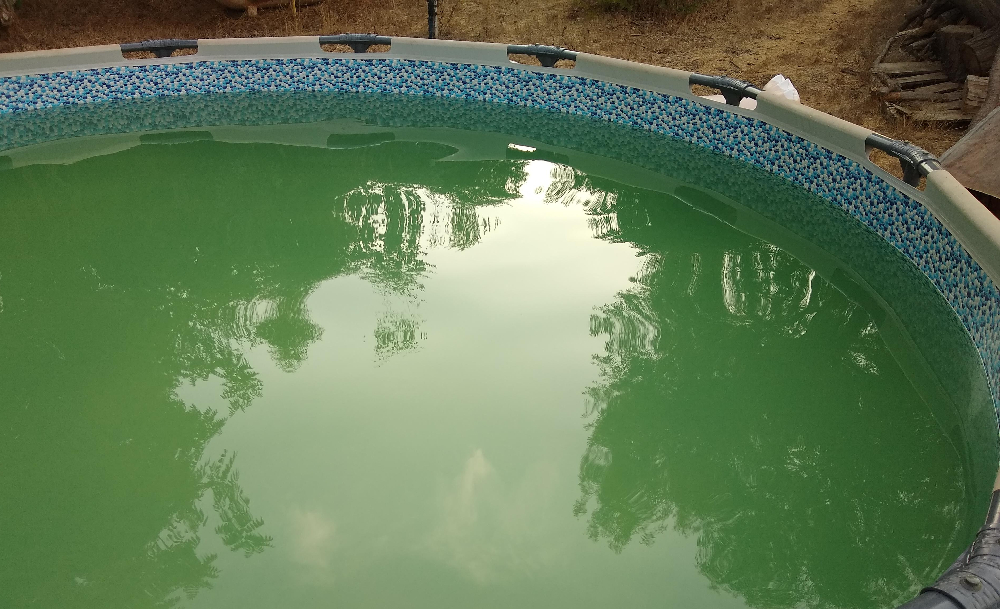
The second reason was that I tested the water. I used the common test strips you can buy at pool stores, and the strips registered the lowest levels of “free chlorine” and “total chlorine.” To compare, I then tested water straight out of my hose. Surprisingly, the water straight out of the hose tested higher in chlorine than the old swimming pool water.
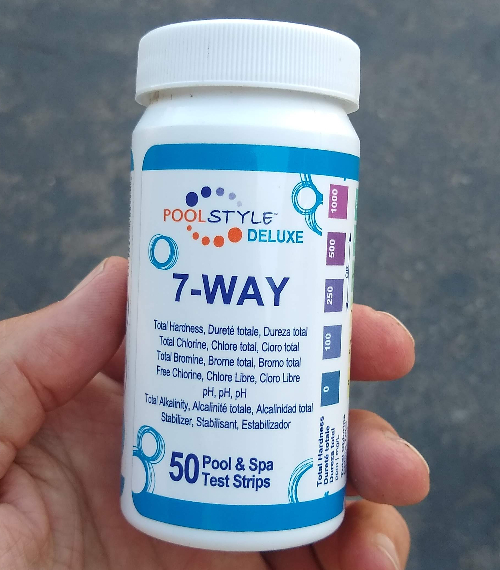
I couldn’t test the sodium level with these strips, but I still went for it and used the water in the yard.
How I used the water
When I used the water in July, I employed an electric pump to gain some pressure so I could feed the water into my irrigation lines. This way the water was applied exactly where it had been all summer by my sprinklers and drip emitters. And I applied the water on citrus trees and avocado trees mostly.
When I used the water in September, I siphoned it out through hoses that I placed under various trees: citrus, avocado, apple, pluot, macadamia. I also fed the water into the driplines on my vegetables.
Results and conclusions
No harm has manifested. But I spread this water among many plants, and it was just a small proportion of the overall irrigation they received all summer, so I would be very surprised to see toxicity symptoms anywhere.
This pool water could be considered a form of gray water. What’s gray water? It’s just water that was relatively clean (having come from the district or well or elsewhere) and was used for some purpose (such as washing clothes or dishes or showering) and then is reused (rather than sent to a sewer or septic system). My pool water was used for swimming and then was reused.
As with other sources of gray water, stuff has been added. In the case of the pool water, it was the chlorine product plus lots of skin and hair detritus from our bodies – instead of detergents, shampoo, soap, etc.
I’ve used water from this pool on the yard in summers past, and I’ve used a lot of other forms of gray water on vegetables and fruit trees over my past twenty years of gardening. The main principle that I’ve seen prove true is that the poison is in the dose. Even a small amount of “dark gray” (very soapy, e.g.) water doesn’t affect the soil or plant as long as it’s chased by abundant clean water.
Why have I written this post? Not because I want to recommend that you do this. I’m just reporting what I’ve done, along with the observed results, because when I searched around the internet for advice on using swimming pool water to irrigate plants I found zero people sharing firsthand experience. I only found people talking theoretically and giving vague warnings. So here I am trying to add concrete and useful information on the topic.
A couple final notes
My experience above has little relevance to draining a large, in-ground pool. Those are a whole different beast in terms of structural concerns and water toxicity and more.
Also, if I were using water from a small, above-ground pool that I’d added chemicals to for more than a month or so, then I’d expect that water to have built up far higher levels of chemicals and other properties that make it more toxic and limit its use. So before considering using it in my yard I would do a more complete test on its quality.
One thought I have going forward is that next summer I might try adding no chlorine at all to the swimming pool. Rather, once it starts to get murky and tint green, I’ll feed it to the yard and then refill. I’ll think of the pool as a holding tank for irrigation that we also get to play in.
The Yard Posts runs on direct support, not on ads. Don’t you think that makes for a better read?
All of my Yard Posts are listed here.

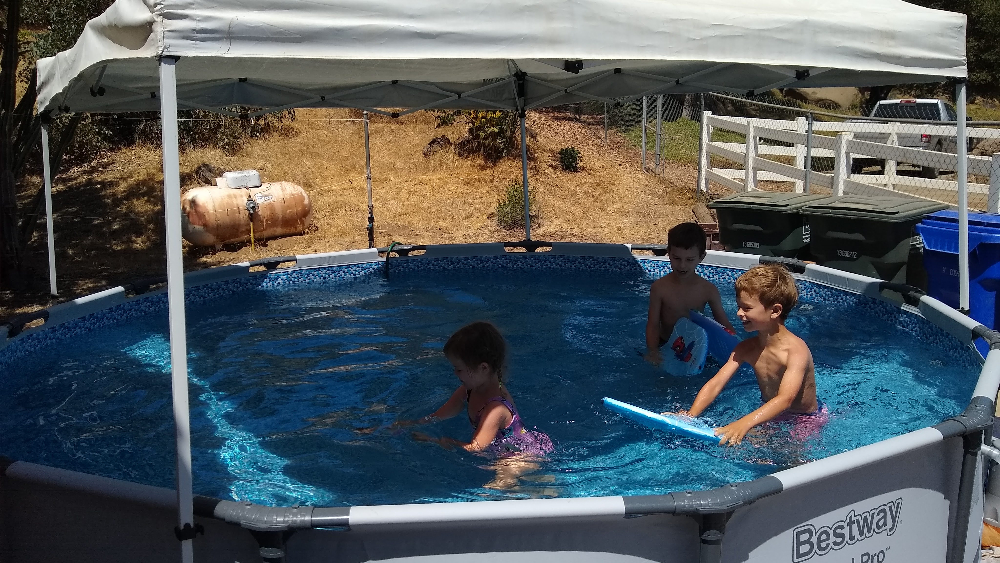


I have 3, 50 gallon rain barrels. I clean them before the winter rains. They fill up completely in the winter and I use that water for acid loving plants such as blueberries. Through the summer the water gets algae and other stuff growing in it. When I installed the first rain barrel I did add a little bleach to the water and then forgot to add bleach again and it got algae growing in it. I used it for watering without fear but would be concerned with a high concentration of bleach killing beneficial bacteria in the soil. I think your idea of filling your pool and then when the water starts to get murky to use it for watering and then refilling it again is a great idea. A suggestion would be to put your pool water into your rain barrels. The chlorine in the water would then neutralize with the bacteria and algae in your rain barrels and help clean them.
I have a sand filter that needs back flushed once in a while on my in ground pool. I do this when the chlorine levels are very low and I let it flow to an area where there are mainly native plants, cactus and a small lychee fruit tree. I’ve done this for 7 years and haven’t had any issues with those plants. My yard is also sloped where the back of my yard is high and the front is low towards the street, so I’m sure during heavy rains the salts get moved out and away from the plants. I also try and treat my pool minimally, being successful in doing the bare minimum of Just in Time to keep things from going green based on experience.
Hey Greg,
we have a 4000 gallon pool like yours and only using EM(effektive microorganisms) which is a natural product without any chemicals. Initially after filling the pool, we ad a quarter gallon of EM and then a cup every two weeks. It works very well for us but most of the time we use a black pool cover. No algae growth but you have to be vigilant to cover the pool cause of the mosquitoes.
Consider using a little plain white vinegar mixed with a sitting body of water (about a cup to a gallon of tap water). Our SC soil is mostly alkaline and a diluted vinegar water supply would be beneficial for some acid loving plants. It will kill algae but over concentrated use will kill roots to plants, so go easy at first. A primer: https://flourishingplants.com/vinegar-on-plants/
thanks for sharing i recently emptied my inflatable hot tub water into my garden, primarily to my citrus trees and bananas. I also waited a week or two until the chlorine levels were registering as non-existent/lowest levels with the test strips. I also saw how the internet all said don’t do it, but a month later all my trees are looking happy. It is the only summer irrigation I have given them so far, as I live 5 miles from the ocean so the summer has been relatively cool so far.
Thanks for this, Joshua! This is the kind of firsthand experience that we need to share with one another.
yes it is very timely that you posted this, as my partner warned me against after some basic internet searching. I went ahead and did it anyway, Seems to be fine so far!